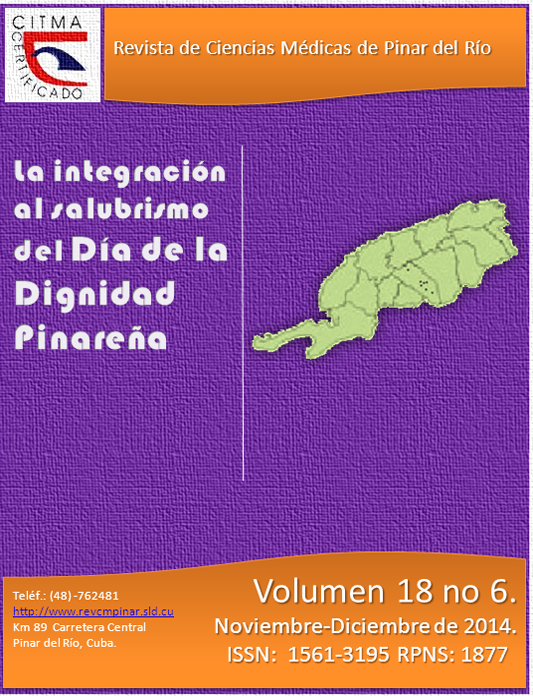Epileptic psychosis and quality of life
Keywords:
Quality of life, Epilepsy, Psychotic disorders.Abstract
Introduction: the levels of psychotic manifestations that come with the epilepsy differ from its natural history and prognosis; these psychopathologic disorders have a close-temporal relationship with the seizures. Lack of knowledge of the main characteristics of epilepsy results in several complications for patients, as it weakens patient’s quality of life.Case report: a 19 year-old female patient, middle-high educational level, married and breastfeeding a 5 months baby, who presented two febrile seizures in her childhood; at present apparently after the breaking-up of her marriage, she began with hearing hallucinations, delirious ideations of religious content, fear and psychomotor anxiety. In clinical interviews her slowness, perseverance in the course of thoughts, sensorial hyperesthesia, severe headache and emotional instability called attention. The studies conducted ruled out the presence of a tumor, but epileptiform discharges were evident in the temporal cortex area.
Conclusions: knowledge about the great variety of psychopathological manifestations that epileptic patients present, their relationship with the seizures and the timely identification modify its natural history, along with the perception the patient has about the disease s/he is suffering from.
Downloads
References
1. Maya Entenza CM. Epilepsia. Editorial Ciencias Médicas. La Habana, 2010.
2. Swinkels WAM, Kuy J, Van Dyck R, Spinhoven PH. Psychiatric comorbidity in epilepsy .Epilepsy Behav 2005; 7: p.37-50.
3. Rochelle Caplan. Psychopathology and Epilepsy: A Two-Way Relationship. Epilepsy Curr. 2012 Sep-Oct; 12 (5): p.201-202.
4. González Pal S, Llanes Basulto Y, Valenti Alonso J, Oliva Hernández I, Fabelo Roche R et al. Factores de riesgo en pacientes adultos con epilepsia y crisis psicógenas no epilépticas. Rev. Hosp. Psiquiatrico de la Habana. [Internet] 2013 [citado 7 Nov. 2013];10 (1). Disponible en: http://www.revistahph.sld.cu/hph0113/hph03113.html
5. Rodríguez Rivera L. Para no cometer errores en la atención al paciente epiléptico. Editorial Ciencias Médicas. La Habana, 2013.
6. Feria Romero I, Alonso Vanegas M, Rocha Arrieta L, Ville Hernández J, Escalante Santiago D, et al. Mecanismos de neurodegeneracion en la Epilepsia del lóbulo temporal. Revista Chil. Neu-Psiquiatria. [Internet] Abril. 2013 [citado 7 Nov. 2013]; 51 (2). Disponible en: http://www.scielo.cl/scielo.php?pid=S0717-92272013000200007&script=sci_arttext
7. Moraleda E, Romero M, Cayetano MJ. Trastornos cognitivos y psicóticos en un caso de epilepsia temporal antes y después de la lobectomía. Avances en Neurol. [Internet] 2011 [citado 7 Nov. 2013]; 2:3. Disponible en: http://www.psiquiatria.com/revistas/index.php/avancesenneurologia/article/viewFile/1180/1099
8. Téllez-Zenteno JF, Ladino LD. Epilepsia temporal: aspectos clínicos, diagnósticos y de tratamiento. Rev Neurol. [Internet] 2013 [citado 7 Nov. 2013]; 56 (4): p.229-242. Disponible en: http://www.google.com.cu/url?sa=t&rct=j&q=&esrc=s&source=web&cd=1&ved=0CB4QFjAA&url=http%3A%2F%2Fwww.researchgate.net%2Fpublication%2F235522959_Temporal_epilepsy_clinical_diagnostic_and_therapeutic_aspects%2Ffile%2F60b7d51807e8c8200a.pdf&ei=E6yxU5zHMdWmsAT _z4CYAw&usg=AFQjCNG2N0EgjBOhTCZx0gavfVz7frBKlQ&bvm=bv.69837884,d.cWc&cad=rja
9. García RJ. Situaciones especiales en adolescentes epilépticos: embarazo, parto y lactancia. Rev Cubana Neurol Neurocir. [Internet] 2012 [citado 7 Nov. 2013]; 2(1): p.47-55. Disponible en: http://www.google.com.cu/url?sa=t&rct=j&q=&esrc=s&source=web&cd=2&ved=0CCQQFjAB&url=http%3A%2F%2Fdialnet.unirioja.es%2Fdescarga%2Farticulo%2F3876647.pdf&ei=fq -xU6XWOrSxsQTN34DgCg&usg=AFQjCNHKfBUio6zuxj-JVG6sCKnpyBM9LQ&bvm=bv.69837884,d.cWc&cad=rja
10. Martínez-Domínguez S, Labrada-Abella J, Pedrós-Roselló A, López-Gomáriz E, Tenías-Burillo JM. Enfermedad mental, rasgos de personalidad y calidad de vida en epilepsia: estudio control de pacientes con epilepsia mioclónica juvenil y otras epilepsias. Rev. Neurol 2013; 56: 608-14.
11. Robaina Becerra H, Fernandez Vidal AT, Ramirez Perez A. Calidad de vida:algo más que un concepto. Medisur [revista en Internet]. 2011 [citado 7 Nov. 2013]; 9 (5): [aprox.4 p.].Disponible en: http://medisur.sld.cu/index.php/medisur/article/view/1718/7349
12. Mora Ripoll R. Medicina del estilo de vida: la importancia de considerar todas las causas de la enfermedad. Rev Psiquiatr Salud Ment (Barc.). [revista en Internet]. 2012 [citado 7 Nov. 2013]; 5(1): [aprox. 5p]. Disponible en: http://zl.elsevier.es/es/revista/revista-psiquiatria-salud-mental--286/medicina-estilo-vida-importancia-considerar-todas-las-90102755-revisiones-2012
13. Torres-Ferrús M, Toledo M, González M, Seró-Ballesteros L, Santamarina E, et al. Etiología y tratamiento de la epilepsia en una serie de 1.557 pacientes. Rev Neurol. [revista en Internet] [citado 7 Nov. 2013]; 57(7): 306-12. Disponible en: http://www.neurologia.com/pdf/Web/5707/bk070306.pdf
Published
How to Cite
Issue
Section
License
Authors who have publications with this journal agree to the following terms: Authors will retain their copyrights and grant the journal the right of first publication of their work, which will be publication of their work, which will be simultaneously subject to the Creative Commons Attribution License (CC-BY-NC 4.0) that allows third parties to share the work as long as its author and first publication in this journal are indicated.
Authors may adopt other non-exclusive license agreements for distribution of the published version of the work (e.g.: deposit it in an institutional telematic archive or publish it in a volume). Likewise, and according to the recommendations of the Medical Sciences Editorial (ECIMED), authors must declare in each article their contribution according to the CRediT taxonomy (contributor roles). This taxonomy includes 14 roles, which can be used to represent the tasks typically performed by contributors in scientific academic production. It should be consulted in monograph) whenever initial publication in this journal is indicated. Authors are allowed and encouraged to disseminate their work through the Internet (e.g., in institutional telematic archives or on their web page) before and during the submission process, which may produce interesting exchanges and increase citations of the published work. (See The effect of open access). https://casrai.org/credit/



